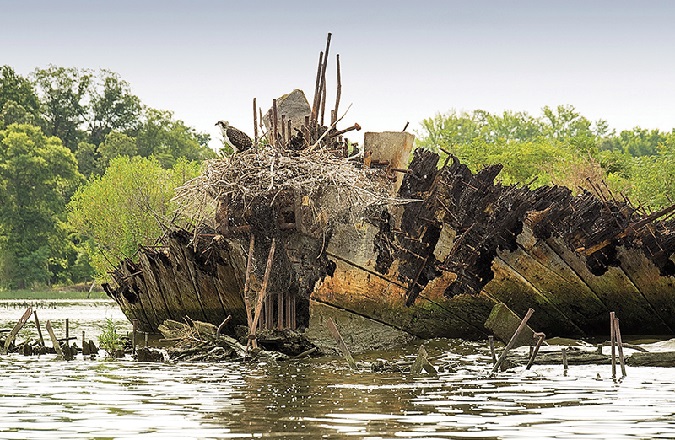Mallows Bay on the Potomac River has been proposed as a national marine sanctuary, the first in the Chesapeake Bay watershed, and now the public has a chance to comment. The National Oceanic and Atmospheric Administration released a draft plan for protecting a portion of the Potomac 40 miles downriver from Washington, DC. It contains nearly 200 known historic shipwrecks, some dating to the Civil War and possibly even the Revolutionary War, plus archeological artifacts as old as 12,000 years related to the region’s American Indian cultures at the time of European settlement.
The area is best known for the remains of more than 100 wooden steamships, known as the Ghost Fleet, many still visible, that were built for the U.S. Emergency Fleet during World War I.
Mallows Bay is one of two new proposed national marine sanctuaries. The other is a 1,075-square-mile area of Lake Michigan that contains 37 known shipwrecks and as many as 80 others to be discovered. Originally proposed in 2014, they would be the first marine sanctuaries created since 2000.

Community groups nominated Mallows Bay in 2014 to be a marine sanctuary, and the next year, NOAA launched a scoping process to determine whether to designate it. Based on strong public support voiced during an earlier comment period, the agency has prepared a draft environmental impact statement evaluating three different boundary configurations ranging from 18 square miles to 100 square miles in size. It also considered the possibility of taking no action.
NOAA’s preferred alternative covers 52 square miles and focuses on protecting and providing access to the “Ghost Fleet” and other historic vessels or maritime sites. The agency said its protections would be “primarily non-regulatory in nature” but would include “limited regulation and permitting of specific activities” in concert with state and local authorities to mitigate threats to the historic resources.
Joel Dunn, president and CEO of the Chesapeake Conservancy, welcomed NOAA’s action, calling Mallows Bay “an incredible place to kayak or canoe.
“Nature has reclaimed these ships as artificial reefs,” Dunn said, “creating a unique place where wildlife and history have come together.” In other marine sanctuaries, wrecks are usually submerged, but in this one, Dunn noted that people can paddle among hulks that are still visible above the water.
To review the draft environmental impact statement and draft management plan, go to sanctuaries.noaa.gov/mallows-bay.
To comment online, go to regulations.gov and for the Mallows Bay sanctuary, use docket number NOAA-NOS-2016-0149. The deadline to comment on the proposed sanctuaries online is March 31.
To mail in a comment, write to:
Paul Orlando, Chesapeake Regional Coordinator
ONMS Northeast & Great Lakes Region
c/o NOAA Chesapeake Bay Office
410 Severn Ave, Suite 207-A
Annapolis, MD 21403
A pair of public meetings are scheduled to answer questions and take comments:
- March 7: 6–9 p.m., Charles County Government Building Auditorium; 200 Baltimore St. La Plata.
- March 9: 6–9 p.m., Anne Arundel Community College, Center for Applied Learning & Technology (CALT) Building, Room 100, 101 College Parkway, Arnold.

